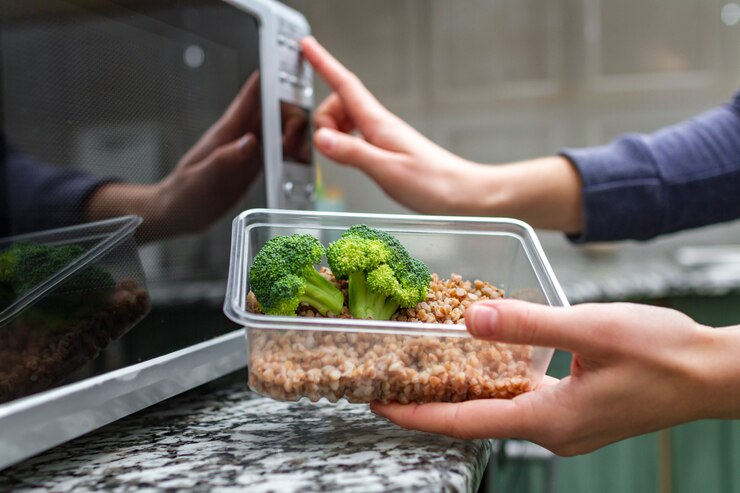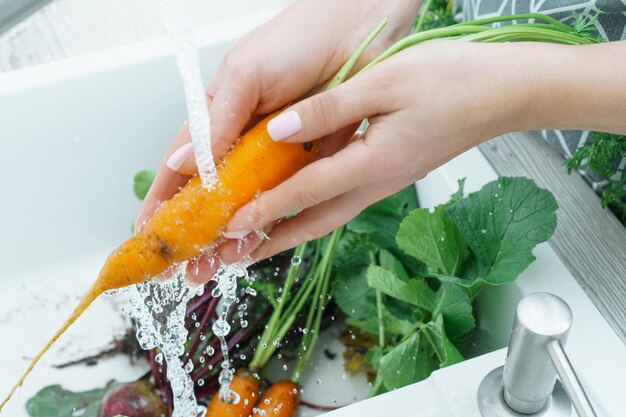
The Importance of Fruit and Vegetable Wash in Daily Routine
Share
In our quest for healthier eating habits, we often emphasize the importance of consuming fruits and vegetables regularly. These colorful, nutrient-packed foods are essential for our well-being, providing vitamins, minerals, fiber, and antioxidants.
However, there's a crucial aspect of including fruits and vegetables in our diets that sometimes gets overlooked – their cleanliness. The contaminants that can cling to these natural wonders pose potential health risks, which is why using fruit and vegetable wash in our daily routines is increasingly important.
Let’s learn the benefits of washing fruits and vegetables and how to do it correctly.

Understanding Fruit and Vegetable Contaminants
Before we delve into the significance of fruit and veggie wash, let's take a moment to understand the contaminants that can be found on the surfaces of these foods. While fresh produce is undoubtedly beneficial for our health, it can also harbor various contaminants:
Pesticide Residues
Pesticides are commonly used in agriculture to protect crops from pests and diseases. While they serve a vital purpose in ensuring food security, traces of pesticide residues can remain on the surface of fruits and vegetables.
Consuming these residues can lead to health concerns, as some pesticides have been linked to adverse effects on human health.
Bacteria and Pathogens
Fruits and vegetables can come into contact with bacteria and pathogens at various stages of their journey from the farm to our plates.
Contaminants like E. coli, Salmonella, and Listeria can cause foodborne illnesses when ingested. These pathogens may be present in soil, water, or during handling and transportation.
Wax Coatings
Many fruits, such as apples and cucumbers, are coated with edible wax to enhance their appearance and shelf life. While these waxes are considered safe for consumption, they can trap dirt, bacteria, and pesticide residues on the fruit's surface.
Soil and Dirt
Dirt and soil residues from the fields where produce is grown can adhere to the skin of fruits and vegetables. Even after thorough rinsing, small particles may remain, potentially carrying contaminants.
Benefits of Using Fruit and Vegetable Wash
Given the potential risks associated with consuming contaminants in fruits and vegetables, it becomes clear why using a dedicated fruit and vegetable wash in our daily routines is crucial.
Let's explore the benefits of incorporating this simple practice into our lives:
Removal of Pesticide Residues
A fruit and vegetable wash is formulated to remove pesticide residues from the surface of produce effectively. This is particularly important for conventionally grown fruits and vegetables, which may have higher pesticide levels than organic varieties.
Elimination of Bacteria and Pathogens
Properly washing fruits and vegetables with a dedicated wash helps eliminate harmful bacteria and pathogens that can cause foodborne illnesses. This step is especially crucial for vulnerable populations such as children, older people, and individuals with weakened immune systems.
Reduction of Wax and Dirt Residues
Fruit and vegetable washes also help in reducing wax and dirt residues. By breaking down these substances, they ensure you're not inadvertently consuming foreign materials and your favorite fruits and vegetables.
How to Properly Wash Fruits and Vegetables
Here's a step-by-step guide to properly wash your fruits and vegetables:
- Gather Your Supplies. You'll need an ultrasonic cleaning machine like Sonic Soak, a clean bowl, washing solution, and fruits and vegetables.
- Prepare the Solution. Follow the instructions on the fruit and vegetable wash product to create the solution. Usually, it involves diluting the wash with water in the bowl.
- Add Sonic Soak in the Water. Place your Sonic Soak device in the bowl with the solution. Ensure that it's fully submerged and that the water covers your produce.
- Turn on Sonic Soak. Activate the Sonic Soak device. It will emit ultrasonic waves, creating microscopic bubbles that will clean your produce effectively.
- Allow Soaking. Let your fruits and vegetables soak in the solution with Sonic Soak for the recommended duration. This ensures that contaminants are dislodged and removed.
- Gently Scrub (if necessary). For produce with thicker or waxier skins, like cucumbers or apples, consider gently scrubbing them with a soft brush while in the solution. This helps remove surface residues effectively.
- Rinse Thoroughly. After soaking and, if necessary, scrubbing, rinse your fruits and vegetables under cool running water. Rinse them thoroughly, ensuring that any remaining contaminants, wash solution, or residues are washed away.
- Pat Dry. You can pat your produce dry with a clean cloth or paper towel, but it's not necessary. Air-drying is generally sufficient.
By following these steps and incorporating an ultrasonic vegetable cleaner into your routine, you can significantly reduce the risk of consuming contaminants, ensuring a safer and more enjoyable eating experience.

Tips for Incorporating Fruit and Vegetable Wash into Daily Routine
Incorporating fruit and vegetable wash into your daily routine doesn't have to be complicated or time-consuming. Here are some practical tips to help you make this practice a seamless part of your daily life:
- Set up a designated area in your kitchen for easy washing access.
- Consider washing your fruits and vegetables in advance, especially for items you snack on frequently.
- Encourage everyone in your household to participate in the washing process.
- For convenience, you can transfer the fruit and vegetable wash solution into a spray bottle. This allows you to quickly and efficiently coat your produce before rinsing.
- Regularly clean and dry the crisper drawers in your fridge to maintain a safe storage environment for your fruits and vegetables.
- Store fruits and vegetables separately to prevent cross-contamination, and be mindful of recommended storage temperatures.
- Stay informed about which fruits and vegetables are more susceptible to pesticide residues and contaminants.
- Make fruit and vegetable washing a habit.
Conclusion
Incorporating fruit and vegetable washing into our daily routines is a small but significant step toward safety and cleanliness. Properly cleaning fruits and vegetables reduces the risk of consuming harmful substances and allows us to enjoy the nutritional benefits these foods offer fully.
So, the next time you reach for that apple or slice into a cucumber, remember the importance of fruit and vegetable wash in your daily routine – it's a simple practice that can profoundly impact your health and well-being.
